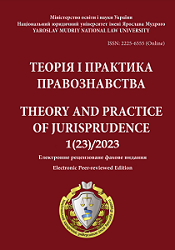Проблемні питання визначення цифрової криміналістики
Problematic Issues of Definition of Digital Forensics
Author(s): Ihor V. Lushchyk, Anatolii S. TiapkinSubject(s): Criminal Law, Civil Law, Criminology, ICT Information and Communications Technologies
Published by: Національний юридичний університет імені Ярослава Мудрого
Keywords: digital criminalistics; digital criminology; forensic digital examination; digital traces; cyberspace;
Summary/Abstract: The article examines the problem of differentiation of the concepts "digital forensics", "digital criminology", "digital forensics", which are widely used today in scientific literature and mass media, and their meaning is revealed. It has been established that scientific and technical progress in the field of combating crime and the general digitization of all spheres of society are closely related to the development of a new field of forensic knowledge – digital forensics and the use of digital evidence in the process of proving. An important role in this process is played by the integration of knowledge, the introduction of the latest innovative developments aimed at solving the problems of combating crime. Digital forensics in Ukraine is developing quite rapidly, which is due, among other things, to new challenges caused by the full-scale invasion of the Russian Federation and the need to develop new remote electronic means of searching, collecting, recording and analyzing traces of criminal offenses. It is emphasized that the development of digital criminology takes place in three main directions: 1) the formation of a separate scientific direction in criminology; 2) application of special knowledge when working with digital evidence; 3) conducting forensic examinations (in particular, computer and technical examinations). In order to classify the main areas of work on law enforcement and crime prevention, general scientific and special research methods were used, namely: analysis, synthesis, abstraction, generalization, as well as systemic, functional and comparative methods. As a result of the research, two large communities have been identified that mainly use digital forensics: law enforcement agencies, which in criminal and civil proceedings use digital evidence to convict or acquit suspects, and incident response teams in enterprises, organizations and institutions, who are the first to respond to cyber-attacks such as data breaches or ransomware threats, while using digital forensics to investigate penetration points and possible remediations. It was concluded that the integration of artificial intelligence in forensics and criminology and the use of machine learning technologies, which has a high potential for automating and accelerating many aspects of investigation and expertise, from the analysis and interpretation of digital evidence to the identification of suspects, is a promising direction of development.
Journal: Теорія і практика правознавства
- Issue Year: 1/2023
- Issue No: 23
- Page Range: 135-160
- Page Count: 26
- Language: Ukrainian

